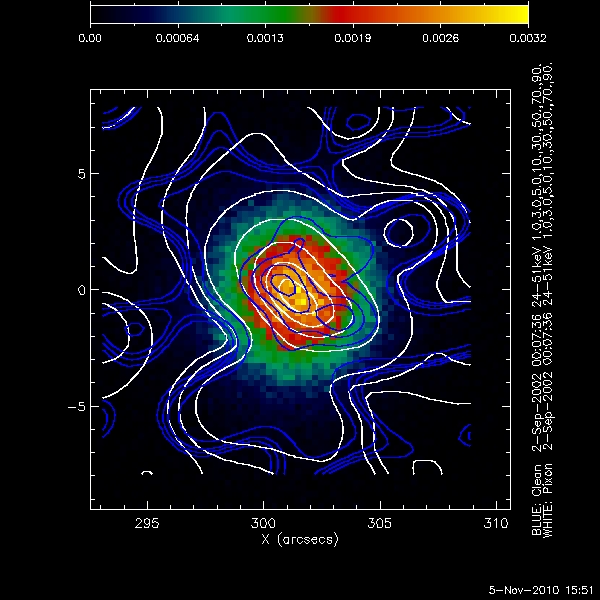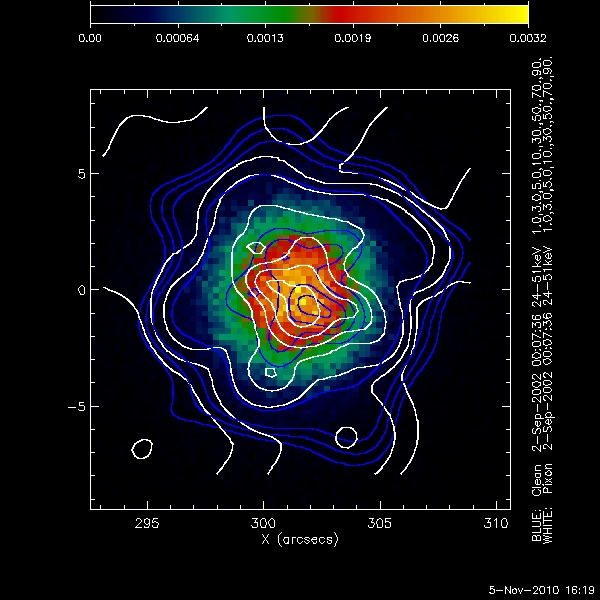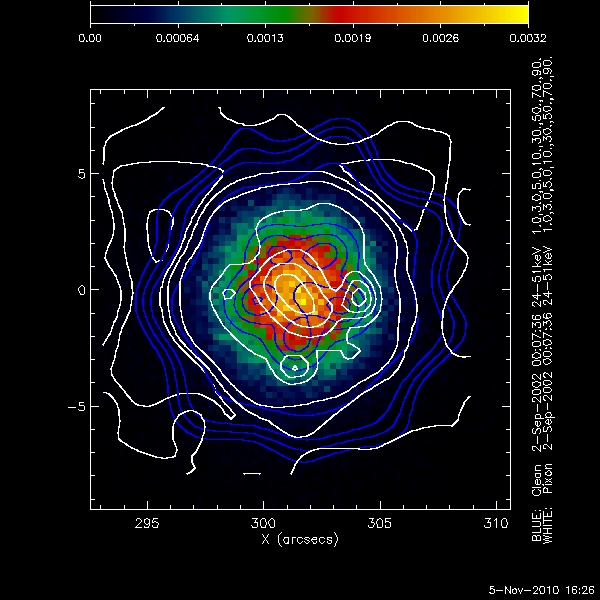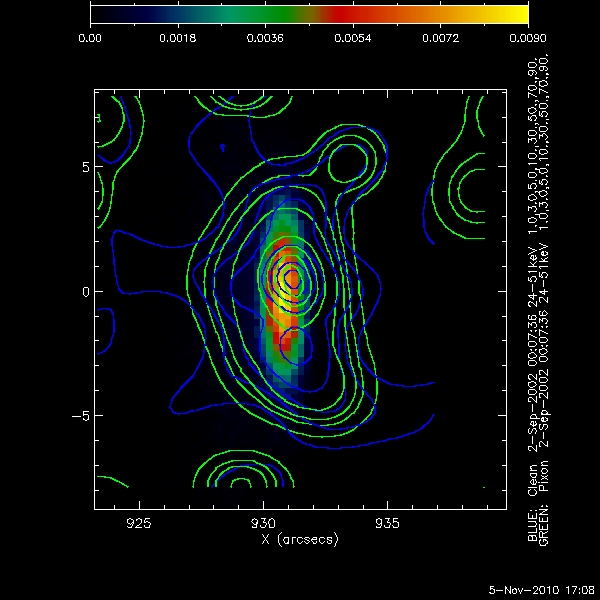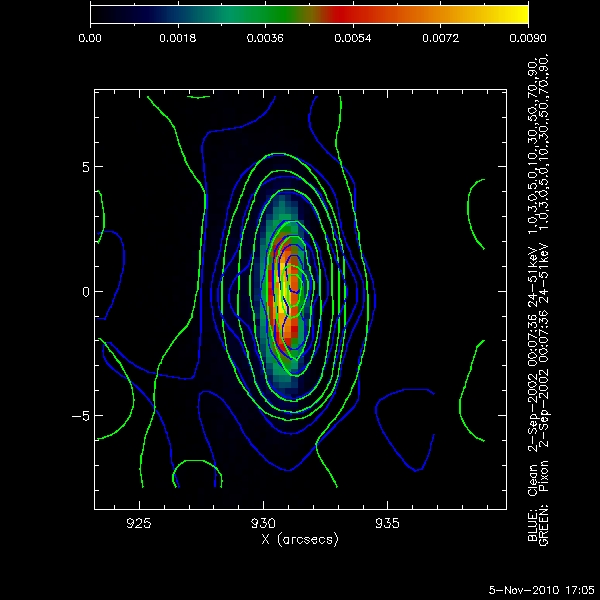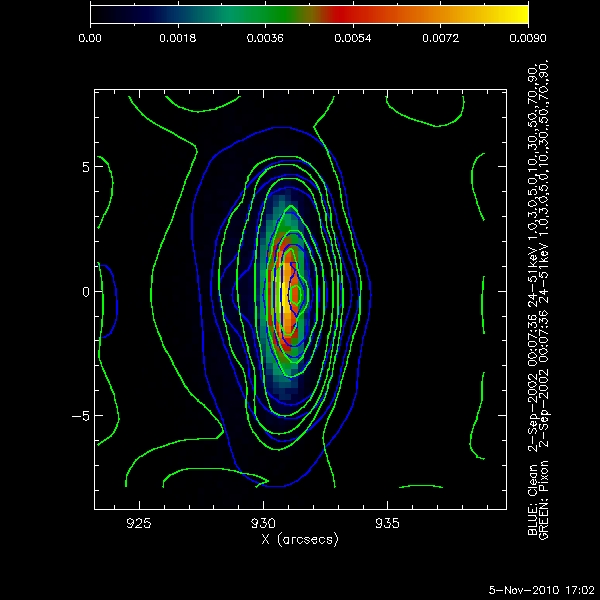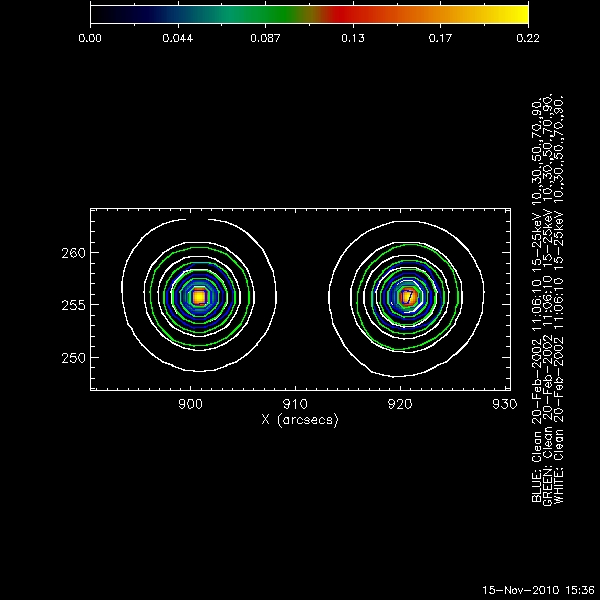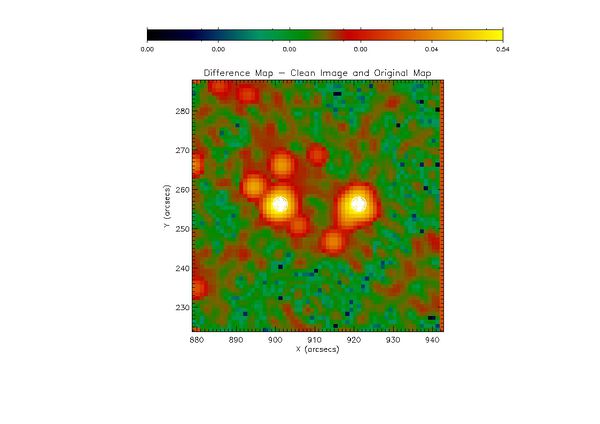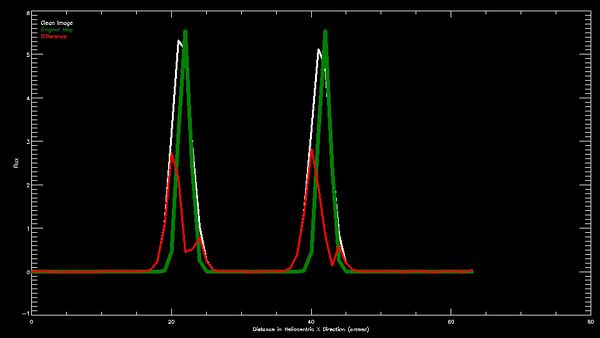Weekly Report 12Nov2010
From RHESSI Wiki
(→Simulated source near the limb (X = 930 arcsec, Y = 0 arcsec)) |
|||
| Line 57: | Line 57: | ||
====Simulated source near the limb (X = 930 arcsec, Y = 0 arcsec)==== | ====Simulated source near the limb (X = 930 arcsec, Y = 0 arcsec)==== | ||
| + | The following images and plots are for the simulated source near the limb at X = 930 arcsec and Y = 0 arcsec. | ||
| + | |||
| + | The plot below shows the clean and pixon contours for an image with approximately 10^4 total counts. | ||
[[Image:Clean pixon low.jpg|center|thumb|600px|The above shows the original data map(background image), the clean contours (Blue), and the pixon contours (White), for ~10^4 total counts in the image.]] | [[Image:Clean pixon low.jpg|center|thumb|600px|The above shows the original data map(background image), the clean contours (Blue), and the pixon contours (White), for ~10^4 total counts in the image.]] | ||
| + | The clean contours do not display the foreshortening effect. The They show a circular compact source along with a very noisy signal at the edges of source. The pixon contours also show a circular compact source. However the contours at the edge do display a foreshortening toward the disc center. | ||
| + | The following plot shows the flux as a function for radial distance from the centroid of the compact source for an image with total counts of approximately 10^4. | ||
[[Image:Flux 930 low avg.jpg|center|thumb|600px|The flux as a function of radial distance from the source centroid. The original map is shown in black dots. The black line represents the average of the flux at a given radial distance. The pixon image is shown in red dots. The purple line represents the average of the flux at a given radial distance. The clean image is shown in green dots. The cyan line represents the average flux at a given radial distance. The total counts in the image is ~10^4.]] | [[Image:Flux 930 low avg.jpg|center|thumb|600px|The flux as a function of radial distance from the source centroid. The original map is shown in black dots. The black line represents the average of the flux at a given radial distance. The pixon image is shown in red dots. The purple line represents the average of the flux at a given radial distance. The clean image is shown in green dots. The cyan line represents the average flux at a given radial distance. The total counts in the image is ~10^4.]] | ||
| + | The plot of radial profile shows that the spread of points at any given radial value is larger than for the source closer to disc center in all cases, including the original data map. The pixon profile does show a small bump at ~4 arcsec that may be an albedo contribution. I would expect an even larger spread at this distance though, due to foreshortening. This is not immediately evident. | ||
| + | The plot below shows the clean and pixon contours for an image with approximately 10^5 total counts. | ||
[[Image:Clean pixon middle.jpg |center|thumb|600px|The above shows the original data map(background image), the clean contours (Blue), and the pixon contours (White), for ~10^5total counts in the image.]] | [[Image:Clean pixon middle.jpg |center|thumb|600px|The above shows the original data map(background image), the clean contours (Blue), and the pixon contours (White), for ~10^5total counts in the image.]] | ||
| + | Once again both imaging methods do a better job as the amount of counts increase. The both image the compact source as an ellipse. In this case pixon is still imaging what appears to be foreshortening at the 1% and 3% contours. It is less clear that this is true of clean. These contours appear symmetric around the center of the source. | ||
| + | |||
| + | The following plot shows the flux as a function for radial distance from the centroid of the compact source for an image with total counts of approximately 10^5. | ||
[[Image:Flux 930 mid avg.jpg|center|thumb|600px|The flux as a function of radial distance from the source centroid. The original map is shown in black dots. The black line represents the average of the flux at a given radial distance. The pixon image is shown in red dots. The purple line represents the average of the flux at a given radial distance. The clean image is shown in green dots. The cyan line represents the average flux at a given radial distance. The total counts in the image is ~10^5.]] | [[Image:Flux 930 mid avg.jpg|center|thumb|600px|The flux as a function of radial distance from the source centroid. The original map is shown in black dots. The black line represents the average of the flux at a given radial distance. The pixon image is shown in red dots. The purple line represents the average of the flux at a given radial distance. The clean image is shown in green dots. The cyan line represents the average flux at a given radial distance. The total counts in the image is ~10^5.]] | ||
| + | Once again there is a clear bump in the pixon profile at approximately the distance we expect to see the albedo. Pixon also shows a bump, but the average of the pixon points points to the fact that it contains very few points, meaning it may be a statistical anomaly. The pixon algorithm may be imaging the albedo contribution or at least the foreshortening of the albedo contribution. | ||
| + | |||
| + | The plot below shows the clean and pixon contours for an image with approximately 10^6 total counts. | ||
[[Image:Clean pixon high.jpg |center|thumb|600px|The above shows the original data map(background image), the clean contours (Blue), and the pixon contours (White), for ~10^6 total counts in the image.]] | [[Image:Clean pixon high.jpg |center|thumb|600px|The above shows the original data map(background image), the clean contours (Blue), and the pixon contours (White), for ~10^6 total counts in the image.]] | ||
| - | + | At the highes number of total counts used both algorithms are imaging the elliptical shape of the compact source. However while the clean algorithm has symmetric contours away from the source, pixon clearly shows more flux towards the disc center. This looks like clear evidence of foreshortening. | |
| - | + | ||
| - | + | ||
| + | The following plot shows the flux as a function for radial distance from the centroid of the compact source for an image with total counts of approximately 10^6. | ||
| + | [[Image:Flux 930 high avg.jpg |center|thumb|600px|The flux as a function of radial distance from the source centroid. The original map is shown in black dots. The black line represents the average of the flux at a given radial distance. The pixon image is shown in red dots. The purple line represents the average of the flux at a given radial distance. The clean image is shown in green dots. The cyan line represents the average flux at a given radial distance. The total counts in the image is ~10^6.]] | ||
| + | Once again pixon shows a bump where we expect the shoulder to appear due to the albedo and foreshortening effects. Looking at the study near disc center and near the limb, it appears that pixon may not be able to image the albedo directly, but can measure the foreshortening of the albedo. | ||
===RHESSI Imaging Algorithm Test - Clean === | ===RHESSI Imaging Algorithm Test - Clean === | ||
Revision as of 13:21, 16 November 2010
Contents |
Pixon Albedo Imaging Results
Using Eduard Kontar's simulated eventlist files, Pixon Images were created for a compact circular gaussian source with an albedo near disk center, and near the limb. The following parameters were used for each image:
- Time: 2-Sep-2002 00:07:36 - 00:08:16
- Energy 24keV - 51keV
- Detectors 1 t0 4
- Image Size: 64 by 64 pixels
- Pixel Size: .5 arcsec by .5 arcsec
In each Image below the following convention was used:
- Background Image: The original data map supplied by Eduard Kontar
- Blue Contours: The Clean Image Contours
- White Contours: The Pixon Image Contours
The Contours levels used were: 1%, 3%, 5%, 10%, 30%, 50%, 70%, and 90%.
The plots below each image show the flux of a pixel as a function of the distance from the centroid of the source. It is a modification of looking at the flux along a single line through the image. In this method every pixel is plotted so the entire image can be viewed. The following conventions were used in all radial profile plots:
- The values of the flux for the original data map were 'normalized' such that the peak value matches the peak value of the Pixon images
- The flux values for each pixel in the original data map are black points
- The flux values for each pixel in the Pixon image are red points
- The flux values for each pixel in the Clean image are green points
- The average value of the flux at each radial distance in the original data map is represented by the solid black line
- The average value of the flux at each radial distance for the Pixon image is represented by the purple line
- The average value of the flux at each radial distance for the Clean image is represented by the cyan line
Simulated source closer to disc center(X = 301 arcsec, Y= 0 arcsec)
The following images and plots of the flux are for the simulated source near the disc center.
The following image is for the source near disc center with the lowest number of total counts, approximately 10^4.
Both imaging techniques produce an elliptical source around the centroid of the original data map. The Pixon image breaks up into multiple smaller sources at the centroid. Neither method reproduces a symmetrical albedo contribution away from the centroid of the image. This may be due to the low number of counts away from the compact source.
The following plot shows the flux as a function of radial distance from the centroid of the source from an image with total counts of approximately 10^4.
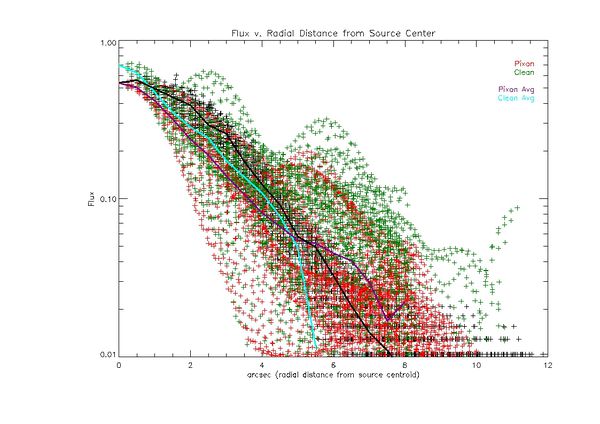
Looking at the plot above the pixon image is more compact around the centroid of the source. The clean image contains multiple bumps, but they seem to be outliers that do not affect the overall average of clean profile greatly. The look like artifacts. I don't think we can say that either method is imaging the albedo.
The following shows the clean and pixon images for an image with total counts of approximately 10^5.
The clean and pixon images both are approximately the size of the compact source. The 3% and 5% contours are both at the very edge of the source. However the 1% contour for clean is clearly defined while the same contour for pixon is in the statistical noise. At this number of total counts clean seems to find structure down to the 1% level. Pixon has a higher flux much farther away from the compact source, this may be an artifact of being at the edge of the image.
The following plot shows the flux as a function of radial distance form the centroid of the compact source for an image with approximately 10^5 total counts.
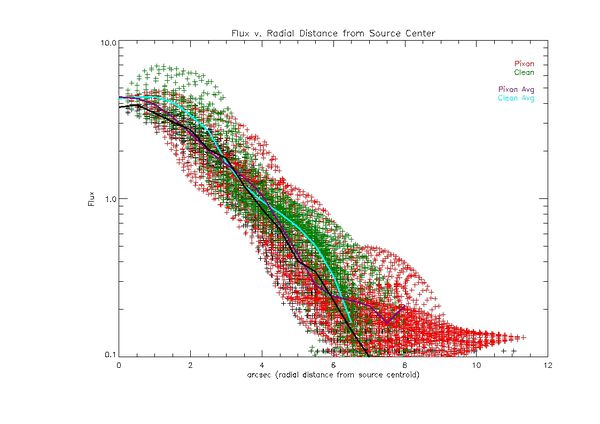
The most noticeable effect of adding counts to the image is the spread of the flux at any given radial distance is smaller. This is encouraging since we know the image is symmetric around the center of the compact source. There are also peaks which show up in the Pixon profile away from the center which may be evidence of the albedo, as they have an effect on the average of the profile at a given radial distance. The discouraging aspect is these peaks do not seem to be present in the average of the profile of the original data map.
The following shows the clean and pixon contours for an image with approximately 10^6 total counts.
Once again in this case both imaging methods do a reasonable job of reproducing the compact source although neither is symmetric. Once again clean seems to do a better job of imaging the edges of the source, while pixon breaks up for the 3% and 1% contours. Does pixon need to use detectors with coarser grids to image the extended source accurately?
The following plot shows the flux as a function for radial distance from the centroid of the compact source for an image with total counts of approximately 10^6.
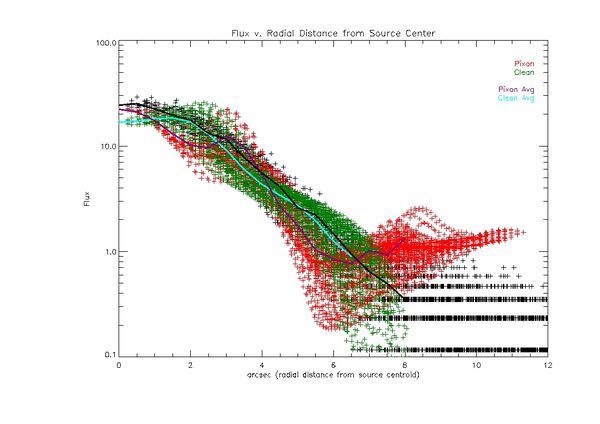
Once again, around the compact source the spread of points is tight for bot the pixon and clean images. As we get farther away from the centroid, the clean image falls off like the original data map, the pixon image however levels up, with a much higher flux farther out from the centroid. There is a sharp rise in the pixon profile at approximately 2.5 arcsec from the center of source, but the shape of the profile changes so significantly it may be an artifact.
Simulated source near the limb (X = 930 arcsec, Y = 0 arcsec)
The following images and plots are for the simulated source near the limb at X = 930 arcsec and Y = 0 arcsec.
The plot below shows the clean and pixon contours for an image with approximately 10^4 total counts.
The clean contours do not display the foreshortening effect. The They show a circular compact source along with a very noisy signal at the edges of source. The pixon contours also show a circular compact source. However the contours at the edge do display a foreshortening toward the disc center.
The following plot shows the flux as a function for radial distance from the centroid of the compact source for an image with total counts of approximately 10^4.
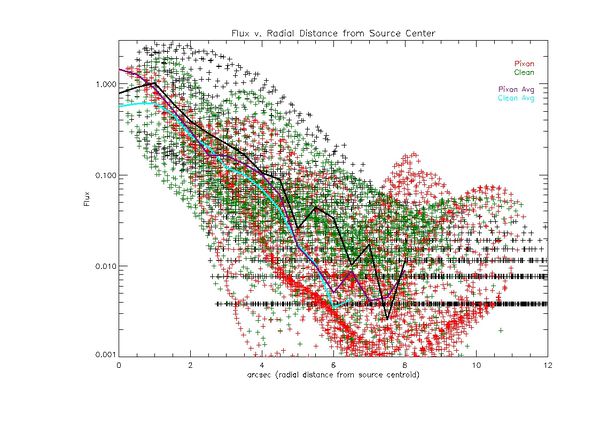
The plot of radial profile shows that the spread of points at any given radial value is larger than for the source closer to disc center in all cases, including the original data map. The pixon profile does show a small bump at ~4 arcsec that may be an albedo contribution. I would expect an even larger spread at this distance though, due to foreshortening. This is not immediately evident.
The plot below shows the clean and pixon contours for an image with approximately 10^5 total counts.
Once again both imaging methods do a better job as the amount of counts increase. The both image the compact source as an ellipse. In this case pixon is still imaging what appears to be foreshortening at the 1% and 3% contours. It is less clear that this is true of clean. These contours appear symmetric around the center of the source.
The following plot shows the flux as a function for radial distance from the centroid of the compact source for an image with total counts of approximately 10^5.
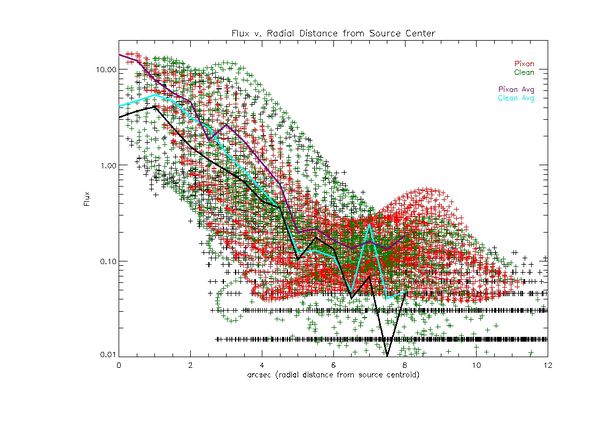
Once again there is a clear bump in the pixon profile at approximately the distance we expect to see the albedo. Pixon also shows a bump, but the average of the pixon points points to the fact that it contains very few points, meaning it may be a statistical anomaly. The pixon algorithm may be imaging the albedo contribution or at least the foreshortening of the albedo contribution.
The plot below shows the clean and pixon contours for an image with approximately 10^6 total counts.
At the highes number of total counts used both algorithms are imaging the elliptical shape of the compact source. However while the clean algorithm has symmetric contours away from the source, pixon clearly shows more flux towards the disc center. This looks like clear evidence of foreshortening.
The following plot shows the flux as a function for radial distance from the centroid of the compact source for an image with total counts of approximately 10^6.
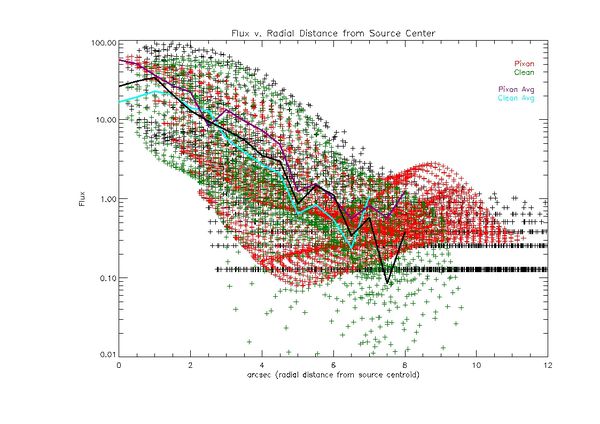
Once again pixon shows a bump where we expect the shoulder to appear due to the albedo and foreshortening effects. Looking at the study near disc center and near the limb, it appears that pixon may not be able to image the albedo directly, but can measure the foreshortening of the albedo.
RHESSI Imaging Algorithm Test - Clean
Following the guidelines for the Annapolis algorithm imaging tests, I attempted to make the best possible clean images using the simulated data sets. Below is a representative attempt.
This test was done with a simulated image consisting of two two arcsec sources, 20 arcsecs apart.
